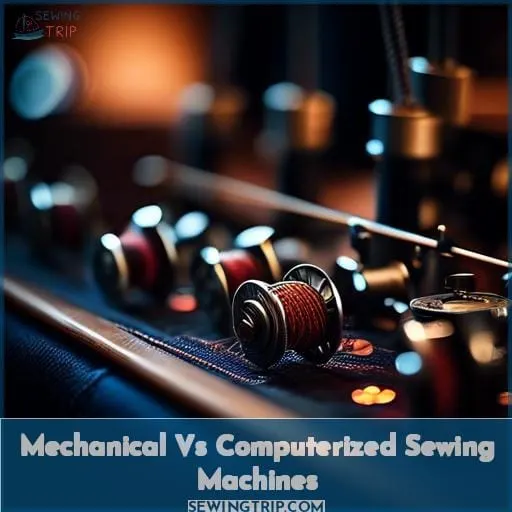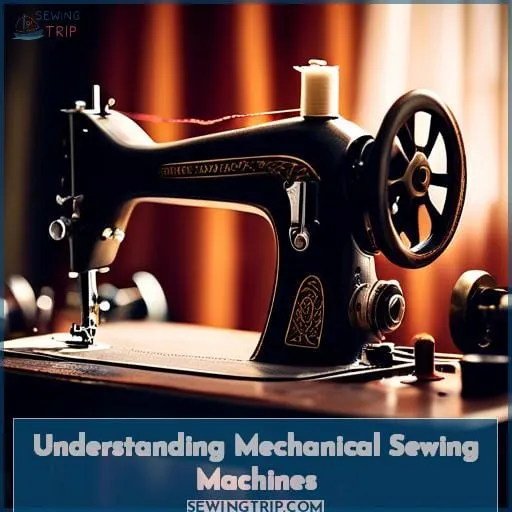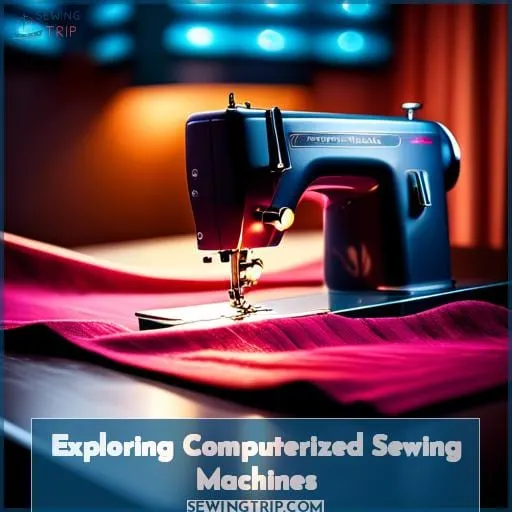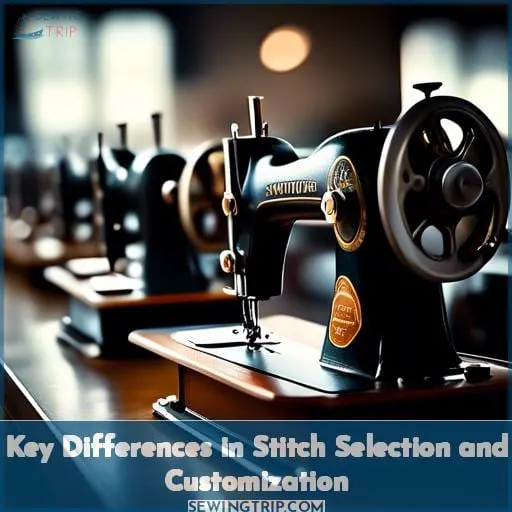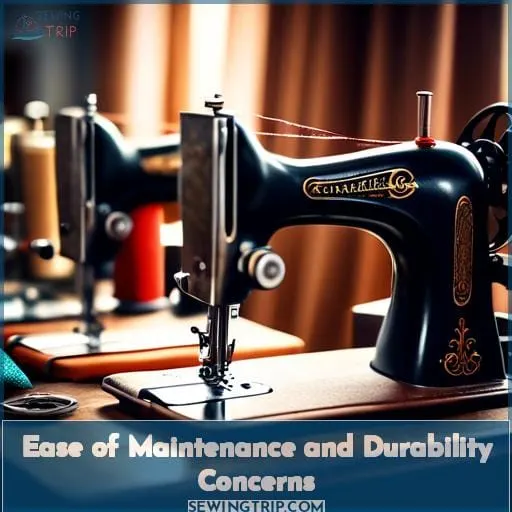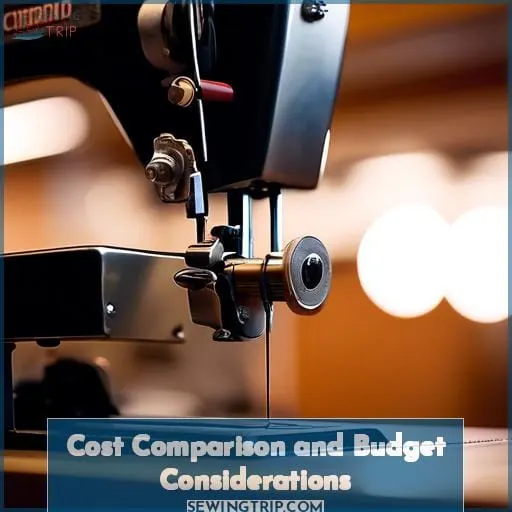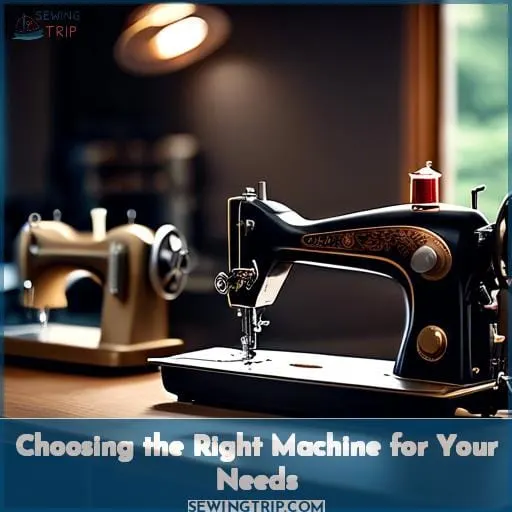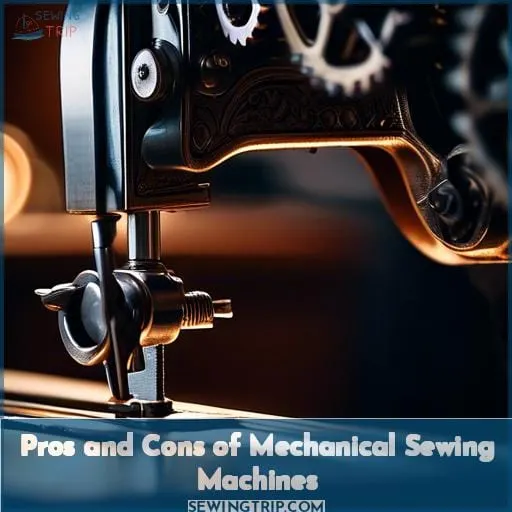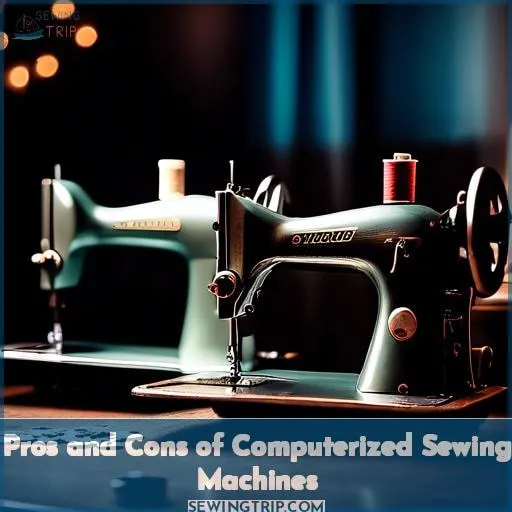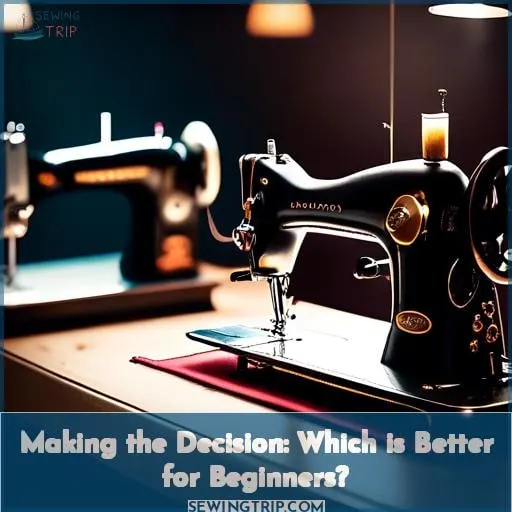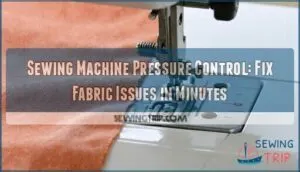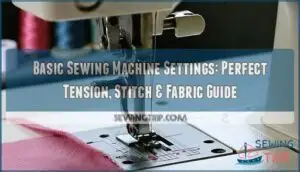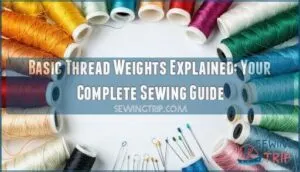This site is supported by our readers. We may earn a commission, at no cost to you, if you purchase through links.
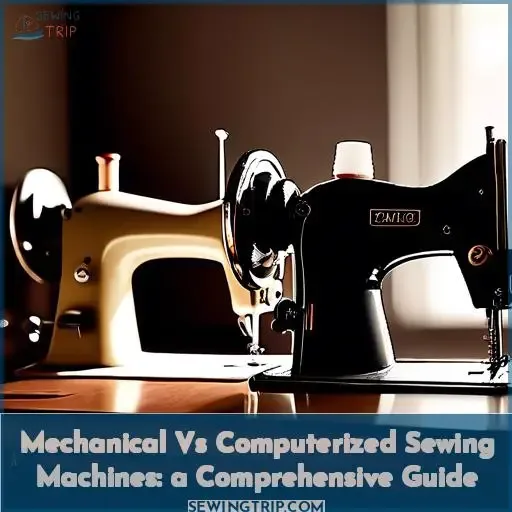 You’re faced with a choice: the reliable simplicity of a mechanical sewing machine or the advanced capabilities of a computerized model.
You’re faced with a choice: the reliable simplicity of a mechanical sewing machine or the advanced capabilities of a computerized model.
This comprehensive guide will help you understand the key differences, from ease of use to stitch customization, and weigh the pros and cons to find the perfect fit for your sewing needs.
Whether you’re a beginner or a seasoned pro, you’ll discover which machine aligns with your desire for innovation and mastery in sewing.
Table Of Contents
- Key Takeaways
- Mechanical Vs Computerized Sewing Machines
- Understanding Mechanical Sewing Machines
- Exploring Computerized Sewing Machines
- Key Differences in Stitch Selection and Customization
- Ease of Maintenance and Durability Concerns
- Cost Comparison and Budget Considerations
- Choosing the Right Machine for Your Needs
- Pros and Cons of Mechanical Sewing Machines
- Pros and Cons of Computerized Sewing Machines
- Making the Decision: Which is Better for Beginners?
- Frequently Asked Questions (FAQs)
- Conclusion
Key Takeaways
- Mechanical sewing machines offer a beginner-friendly learning curve and intuitive controls, making them easy to start using with limited features, which is ideal for those new to sewing or who prefer simplicity.
- Computerized sewing machines come with a steep learning curve and require technical knowledge, but they provide advanced features such as custom stitch preferences, automatic needle positioning, and a wide range of decorative stitch patterns, catering to more experienced sewists looking for versatility.
- While mechanical sewing machines may require more skill for precision stitching and are suitable for heavy-duty projects, computerized machines can produce higher quality results with features like embroidery designs and reduced puckering or crooked seams.
- Mechanical machines are generally easier to maintain, have a longer lifespan, and come at a lower initial investment cost, making them a cost-effective option in the long run. In contrast, computerized machines may offer advanced features and convenience but come with a higher price point and potentially higher maintenance costs.
Mechanical Vs Computerized Sewing Machines
Choosing between a mechanical and a computerized sewing machine feels like deciding between a trusty steed and a high-speed train. Both have their charm, but your choice hinges on your skill level, the complexity of your projects, and what you value in your sewing journey.
Mechanical sewing machines, with their straightforward features and durable build, are like old friends—reliable and easy to maintain.
On the flip side, computerized sewing machines are the wizards of the sewing world, brimming with features that can turn complex projects into a breeze. They offer a vast array of stitches, automatic settings, and the ability to handle diverse fabrics with ease.
Your decision should weigh the importance of accessories, durability, longevity, and the anticipated adventure your sewing machine will embark on with you.
Understanding Mechanical Sewing Machines
When considering mechanical sewing machines, focus on their ease of use, features, and the quality of the final product they produce.
Understanding these aspects will help you make an informed decision between mechanical and computerized sewing machines.
Ease of Use
Diving into mechanical sewing machines, you’ll find they’re a breeze for beginners. Think of them as the trusty old bike you learned to ride on—straightforward and reliable.
- Beginner learning curve: Practically flat, making it a cinch to start stitching.
- Maintenance requirements: Low; a bit of oil and love keeps them purring.
- Cost-to-feature ratio: High value; affordable yet capable, like the Janome 2212 and Brother CS6000i.
Features
After mastering the basics on your mechanical sewing machine, you’ll find its features straightforward but limited.
You’ve got your essential stitch types, but if you’re itching for more—say, automatic features or embroidery capabilities—then a computerized companion might just tickle your fancy.
With a treasure trove of stitch options, an LCD screen, and speed control, it’s a tech-savvy tailor’s dream, albeit with a steeper learning curve.
Quality of Final Product
When you dive into sewing, the quality of your final product shines with mechanical sewing machines. They’re champions of durability, offering stitch precision that stands the test of time.
While lacking advanced features, their straightforward fabric handling boosts your user experience. Perfect for quilting, these versatile workhorses bring undeniable benefits to your craft, proving sometimes, simpler is indeed better.
Exploring Computerized Sewing Machines
You’ll discover that computerized sewing machines offer unparalleled stitch customization, allowing you to tailor every project to your exact specifications.
They also provide a vast array of features and the versatility to tackle advanced sewing functions with ease.
Stitch Customization
Dive into the world of computerized sewing machines, where custom stitch options are your playground.
Adjust stitch length and width with a tap, and move the needle position to suit your project.
Fancy decorative stitch patterns? You’ve got it. These machines offer a plethora of functions, making every stitch a testament to your creativity.
Say goodbye to the cons of mechanical limitations and hello to endless possibilities.
Wide Range of Features
After diving into stitch customization, let’s explore the wide range of features that set computerized sewing machines apart.
- Embroidery capabilities that turn fabric into art.
- An automatic needle threader and drop-in bobbin system for hassle-free setup.
- A touch screen, often an LCD, offering a gateway to endless creativity with a large embroidery area.
These features make machines like the Singer Quantum Stylist 9960 a dream for those craving innovation and mastery in their sewing projects.
Versatility and Advanced Functions
Dive into the world of computerized sewing machines and you’ll find a treasure trove of embroidery options, quilting capabilities, and decorative stitches that turn any fabric into a masterpiece.
These machines are the workhorses of creativity, adeptly handling complex projects with ease. While the price tag might be higher, the vast array of features far outweighs the limitations of their mechanical cousins.
Key Differences in Stitch Selection and Customization
You’ll notice a significant difference in stitch variety and customization between mechanical and computerized sewing machines.
While mechanical models offer simplicity, computerized ones allow for greater flexibility and a broader range of options.
Stitch Variety Expansion
Based on the information provided in the sources, here is a detailed comparison between mechanical and computerized sewing machines:
-
Ease of Use:
- Mechanical machines are simpler to operate with intuitive dials for stitch selection, width, length, and tension.
- They’re beginner-friendly and have markings that make them easy to start using.
-
Features:
- Basic features with manual adjustments required for stitch settings.
- Quality of Final Product: While they value simplicity, they may require more skill to achieve accuracy in stitching.
-
Stitch Customization:
- Computerized machines offer custom stitch preferences, automatic features like needle positioning, backstitches, and more.
- They provide a wide range of features and advanced functions for versatile sewing projects.
-
Key Differences in Stitch Selection and Customization:
- Computerized machines have a vast selection of stitches, including elastic stitches and buttonholes.
- They offer more control over speed, no foot pedal option, and higher quality results with reduced puckering or crooked seams.
-
Maintenance:
- Mechanical machines are easier to maintain due to their simpler design.
- Computerized machines may require more maintenance due to their complex electronic components.
-
Cost:
- Mechanical machines are generally less expensive upfront compared to computerized machines.
- Computerized machines come at a higher price point due to their advanced features and technology.
- Consider the type of sewing projects you’ll be working on.
- Evaluate your comfort level with technology and desired features against your budget constraints.
-
Pros:
- Lower price point.
- Easy maintenance.
- Suitable for heavy-duty projects.
-
Cons:
- Limited stitch options.
- Fewer automatic features.
- May be more complicated for beginners.
-
Pros:
- Automatic features like needle threader, thread cutter, etc.
- Wide range of stitches and buttonholes.
- More control over speed and precision.
-
Cons:
- Higher initial cost.
- Overcomplicated for some users.
- Shorter lifespan compared to mechanical machines.
In conclusion, the choice between mechanical and computerized sewing machines depends on your sewing needs, technological comfort level, budget, and desired features. Each type has its advantages and limitations, so it’s essential to consider these factors carefully before making a decision.
Customization Flexibility
Dive into the sea of customization with computerized sewing machines! They’re your magic wand for embroidery options, turning fabric into tapestries of your imagination.
With advanced features, stitch quality becomes your canvas, and fabric weight merely a detail.
Learning Curve Differences
Switching to a computerized sewing machine can feel like you’re learning to ride a bike all over again.
The learning curve can be steep, especially if you’re not from the tech-savvy age range.
But don’t fret! With a plethora of teaching resources available, even those with zero prior experience can conquer the initial physical challenges and master the art of digital stitching.
Ease of Maintenance and Durability Concerns
You’ll need to consider how easy it is to maintain your sewing machine, whether it’s mechanical or computerized.
Durability concerns also play a big role in deciding which type suits you best.
Mechanical Machine Maintenance
Shifting gears from stitch wizardry to the nuts and bolts, let’s talk shop about your mechanical sewing machine’s upkeep.
You’ll want to keep a keen eye on oiling frequency and stick to a regular lubrication schedule. Remember, a stitch in time saves nine, so don’t skimp on bobbin replacement or needle cleaning.
And for smooth sailing, keep that thread tension adjustment just right.
Computerized Machine Maintenance
Switching gears to your computerized sewing machine, you’ll find maintenance is a tad more nuanced. Regular cleaning procedures keep it humming, while lubrication requirements are less hands-on but crucial.
You’ll face troubleshooting tips that read like secret codes, but fear not—warranty coverage often has your back.
Cost Comparison and Budget Considerations
You’ll need to consider the initial cost differences between mechanical and computerized sewing machines as they can be quite significant.
Assessing the long-term value and potential feature-related expenses is crucial to making a smart investment in your sewing future.
Initial Investment Differences
When diving into the sewing machine market, you’ll notice a stitch in your wallet depending on your choice.
- Accessories included: Computerized machines often come with more bells and whistles.
- Warranty differences: Longer warranties might favor certain models.
- Power consumption: Consider the energy appetite of your machine.
- Sale availability: Keep an eye out for deals.
- Voltage compatibility: Essential for international sewers.
Long-Term Value Assessment
When assessing long-term value, think of your sewing machine as a trusty sidekick.
| Factor | Mechanical | Computerized |
|---|---|---|
| Durability | High | Moderate |
| Maintenance Costs | Lower | Higher |
| Feature Longevity | Basic but steady | Advanced but may age quickly |
Feature-Related Expenses
When weighing sewing machine options, consider the long haul:
- Accessories cost: Computerized machines may require pricier extras.
- Maintenance frequency: Mechanical models often need less fuss.
- Repair complexity: Fixing a computerized unit can be a headache.
- Thread compatibility: Some threads play nice only with certain machines.
- Energy consumption: Mechanical machines typically sip less power.
Choose wisely; your wallet will thank you later!
Choosing the Right Machine for Your Needs
When selecting a sewing machine, it’s crucial to consider the types of projects you’ll tackle, your comfort with technology, and how the features align with your budget.
You’ll want a machine that meets your specific sewing needs without stretching your finances too thin.
Type of Sewing Projects
After considering your budget, let’s dive into the types of sewing projects you’re itching to tackle. Your choice between mechanical and computerized machines hinges on the fabric types, thread compatibility, project complexity, stitch variety, and, yes, those pesky budget constraints.
| Feature | Mechanical | Computerized |
|---|---|---|
| Fabric Types | Limited | Extensive |
| Thread Compatibility | Basic | Advanced |
| Project Complexity | Simple | Complex |
| Stitch Variety | Basic | Wide |
| Budget Constraints | Lower | Higher |
Choose wisely, and happy sewing!
Technological Comfort Level
After considering the type of sewing projects you’re interested in, it’s crucial to assess your comfort with technology.
- Learning curve: Are you ready to climb it or prefer a straight path?
- Technical support: Check availability for peace of mind.
- Warranty options and repair costs: A safety net for your investment.
- User reviews: They’re the real MVPs, offering insights and laughs.
Desired Features Vs Budget
When balancing your desires against your wallet, it’s like walking a tightrope. You’re aiming for that sweet spot where value proposition meets your sewing aspirations.
| Feature | Mechanical | Computerized |
|---|---|---|
| Accessories | Basic | Extensive |
| Bulkiness | Less bulky | Can be bulky |
| Value Proposition | High for beginners | Depends on usage |
| Embroidery Focus | Limited | High |
| Janome Upgrade | Not applicable | Significant leap |
Pros and Cons of Mechanical Sewing Machines
You’re considering a mechanical sewing machine, so let’s weigh the pros and cons.
They’re known for their durability and ease of maintenance, but offer limited stitch options and features.
Advantages
Diving into mechanical sewing machines, you’ll find their simplicity is their superpower. No need to wrestle with a steep learning curve; you can jump straight into stitching.
They’re like the trusty old pickup truck of the sewing world—easy to fix, lower maintenance costs, and they get the job done.
But, don’t expect the fancy embroidery capabilities or a vast stitch variety of their computerized cousins.
Limitations
When you’re eyeing a mechanical sewing machine, remember:
- Durability comparison: They’re tough cookies, but sometimes not as long-lasting as their computerized cousins.
- Stitch quality difference: You’ll get the basics down pat, yet those fancy stitches might be out of reach.
- Beginner’s learning curve: It’s a walk in the park to start, but mastering advanced features? That’s another story.
Pros and Cons of Computerized Sewing Machines
Switching gears to computerized sewing machines, you’re stepping into a world where convenience meets creativity. These machines are like the Swiss Army knives of the sewing universe, packed with features that make sewing feel like a breeze.
| Pros | Cons |
|---|---|
| Embroidery capabilities | Durability concerns |
| Automatic tension adjustment | Higher initial cost |
| Needle threading & Speed control | Steeper learning curve |
You’ve got the power of embroidery at your fingertips, alongside automatic tension adjustment and needle threading, not to mention the speed control that lets you zip through projects at your own pace.
However, keep in mind the durability concerns and the dent in your wallet. And if you’re not tech-savvy, there might be a bit of a learning curve.
Making the Decision: Which is Better for Beginners?
As a beginner, you’re probably looking for a sewing machine that’s as friendly as a neighbor’s dog and won’t have you pulling your hair out. Mechanical machines are the go-to for their simplified controls and no-frills approach.
They’re like the trusty old bike you learned to ride on—affordable and reliable.
On the flip side, if you’re itching to dive into the deep end and get your hands on all the latest gizmos, a computerized machine might just tickle your fancy. They come with a steeper learning curve, but the abundance of learning resources and technical support can smooth out the wrinkles.
Just remember, the best machine is the one that you’ll actually use, not the one collecting dust like an old yearbook.
Frequently Asked Questions (FAQs)
Can I upgrade my mechanical machine to computerized?
You can’t turn a mechanical sewing machine into a computerized one, but you can certainly trade up for a model with all the digital bells and whistles!
How does humidity affect sewing machine performance?
Imagine your sewing machine as a delicate dancer, where humidity is the stage.
Too damp, and the metal parts rust, gears stick.
Too dry, and static builds, threads tangle.
Balance is key for a flawless performance.
Are there hybrid sewing machines available?
Yes, hybrid sewing machines that combine sewing and embroidery functions are available.
Can computerized machines handle power fluctuations?
Throw caution to the wind—computerized sewing machines can be sensitive to power fluctuations. Using a surge protector can shield them from unexpected jolts and keep your projects running smoothly.
Do sewing machines need special insurance coverage?
Yes, sewing machines, especially high-value or those used for business, may need special insurance coverage to protect against loss, damage, or theft.
Conclusion
Stepping into the sewing arena, choosing between mechanical and computerized sewing machines can feel like navigating a labyrinth.
Yet, armed with this guide, you’re now equipped to make an informed decision.
If you value simplicity and reliability, a mechanical machine might be your ally.
Conversely, for those craving innovation and versatility, a computerized model could be your champion.
Ultimately, aligning your sewing ambitions with the right machine will ensure your creative journey is both fulfilling and enjoyable.

